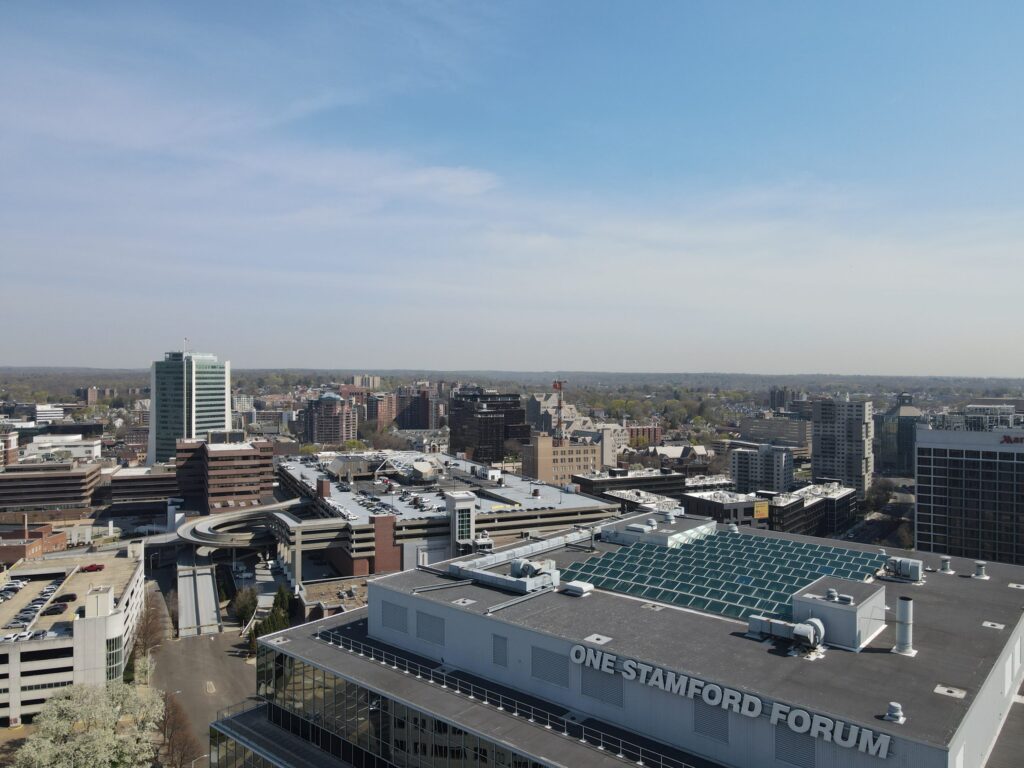On April Fool’s Day in 1949, with unintended irony, the Town of Stamford and the City of Stamford united to form a single government with a new charter. The administrative functions were distributed between an elected Mayor, Board of Representatives, Finance, and Education. The forty-member board of Representatives is one of the larger legislative bodies in Connecticut and is made up of 2 members from each district.
But Stamford’s history goes back much farther. The oldest house in Stamford is the Hoyt-Barnum house, built-in 1699. It stood at 713 Bedford street for centuries until the David Martin administration decided to relocate it to the Fort Stamford park. It was purchased by the City of Stamford in 1942 and restored to its original condition over a two-year period during the late 60s and early 70s.
Fort Stamford is located at 99 Westover Road and was built dusting the Revolution at a time when the people of Stamford and Greenwich were feeling the heat from the fire razing British who had set fire to the towns of Fairfield and Norwalk. The fort is about 7 acres of gardens and four redoubts that make up the site.
The land that is now Stamford, was originally purchased from the native Rippowam by settlers from the New Haven Colony on July 1, 1640. Within a few months, the first real estate sale occurred when the New Haven Colony sold the land to twenty-eight men from the Wethersfield Colony for one hundred bushels of corn. According to lore, the original sale was for twelve coats, twelve Howes, twelve hatchets, twelve glasses, twelve knives, two kettles, four fathom of white wampum. However, the payment wasn’t made in full, causing another deed to be drawn up in 1655 with further explanation, in favor of the settlers, stating that the Indians received four coats for the land and accepted them for “full satisfaction” and that the boundaries of the “purchased” land included parts of the present-day towns of Greenwich, pound Ridge, New Canaan, and Darien.
Records show continuing disputes and clarifications directing the Indians that they had no rights to the land, that the small 20-acre parcel they planted would only remain theirs if they fence it in, and that if they ever leave this parcel they would lose it, and to top it off they could not move additional Indians onto the land. By 1868, Rev. E. B. Huntington described the transaction as the unfortunate result of three hundred “brawny red men with their dusky mates and bright-eyed little ones” trading away their heritage.
Today section of Stamford is called Shippan after the sagamores of the Shippan and Toquam tribes. Wascusee Lane is named after the sachem (chief) of the Shippans. The Rippowam River runs through the city, and the Mianus River is named after another sachem called Myanos. Local schools bear Indian names, Rippowam high school, and the Toquam elementary school.
The stone wall along Bedford street at the First Presbyterian Church, 1101 Bedford Street, contains a series of tablets that recognize significant events, institutions, and individuals in the history of Stamford, particularly those with a religious impact, from 1641-1975.
The legend of pirate treasure in Stamford is linked to the growth of the harbor and imported goods arriving. That would be on account of Captain Kidd. The Stamford History Society wrote:
“The Earl of Bellmont, in a report to the English Lords of Trade, said of Stamford. “There is a town called Stamford in Connecticut colony, on the border of this province, where one Major Selleck lives. He has a warehouse close to the sea, that runs between the Mainland (Long Island). That man does great mischief with his warehouse, for he receives abundance of goods from our vessels, and the merchants afterwards take their opportunity of running them into this town. Major Selleck receives at least ten thousand pounds worth of treasure and East India goods, brought by one Clarke of this town from Kidd’s sloop and lodged with Selleck.”
Stamford History Society
While no pirate loot was ever found, the conflict between taxes, the British and the Indians led Stamford down the path of supporting the American Revolution and gave birth to the industrial town that spawned investments in rails and roads into the 19th century.
Like much of Connecticut waves of European immigrants came to escape whatever was going on in their home country and for the jobs that were plentiful here. By the 20th century, buildings in the downtown began to look like the buildings of a small city. Erasing the colonial roots of Stamford’s past was accomplished through the assimilation of grand revival-style buildings that sprouted up. The cluster of Old Town Hall, the Ferguson Library (the old part), and the Palace Theater are good examples of this.
New York City supplied a steady stream of business and residents. Wealthy New Yorkers built summer homes on Shippan Point, Strawberry, Palmer, and Noroton hills as well as in rural North Stamford. But industry and business dominated the growth of Stamford. By 1916, Yale and Towne was Stamford’s principal employer with an employment base of 6500 workers. By 1937, Yale and Towne was a shell of its former self and had moved its executive offices to New York City. It took a strike in the 1940s to kill the company.
But new companies came in to replace the war industry companies. Stamford is the birthplace of the electric dry shaver, Colonel Jacob Schick employed almost 1,000 workers at the Schick Dry Shaver Company on Atlantic Street. Much later GTE, Pitney Bowes, Xerox, and Champion Paper formed the big corporate backbone of Stamford. But to get there, Stamford needed to undergo yet another change.
This time it was the redevelopment wave that gutted cities across America.
A 130-acre part of the downtown was set aside for a new way of building. Old style 19th-century charm gave way to apartment towers and modern office buildings.
One Landmark Square was completed in 1972, a 300,00 SF office building which for 37 years was the city’s tallest, it was the completion of the GTE World Headquarters in 1973 that became the catalyst for downtown office development. You can see the results along Tresser Blvd. But suburban office parks were also needed, and High Ridge road became home to several office parks like High Ridge Park.
Over the years, other developers have added things like the decaying Stamford Town Center Mall, many midrise apartments buildings. UBS and RBS were lured from NYC to Stamford by advantageous state and local tax incentive programs.
By 2010, big development projects took over the former industrial south end and filled lots with high-rise apartment towers. Stamford discovered its waterfront and built the amenities that promoted active use replacing boatyards and manufacturing.
Today Stamford is the second-largest city in Connecticut.



